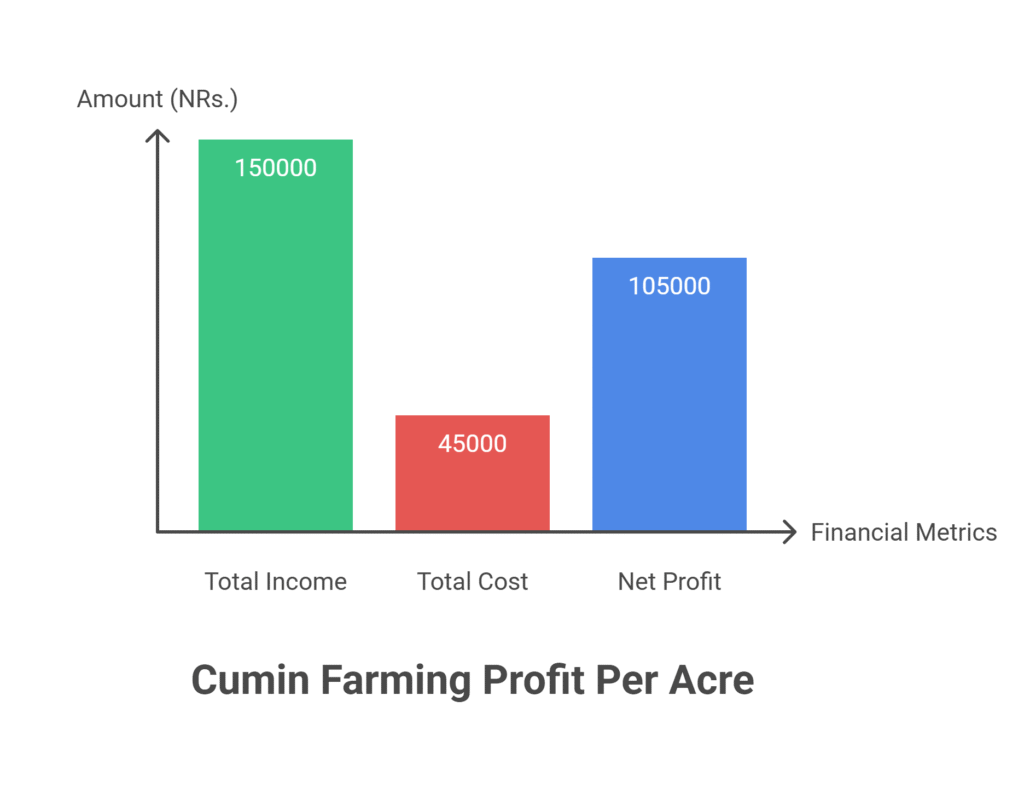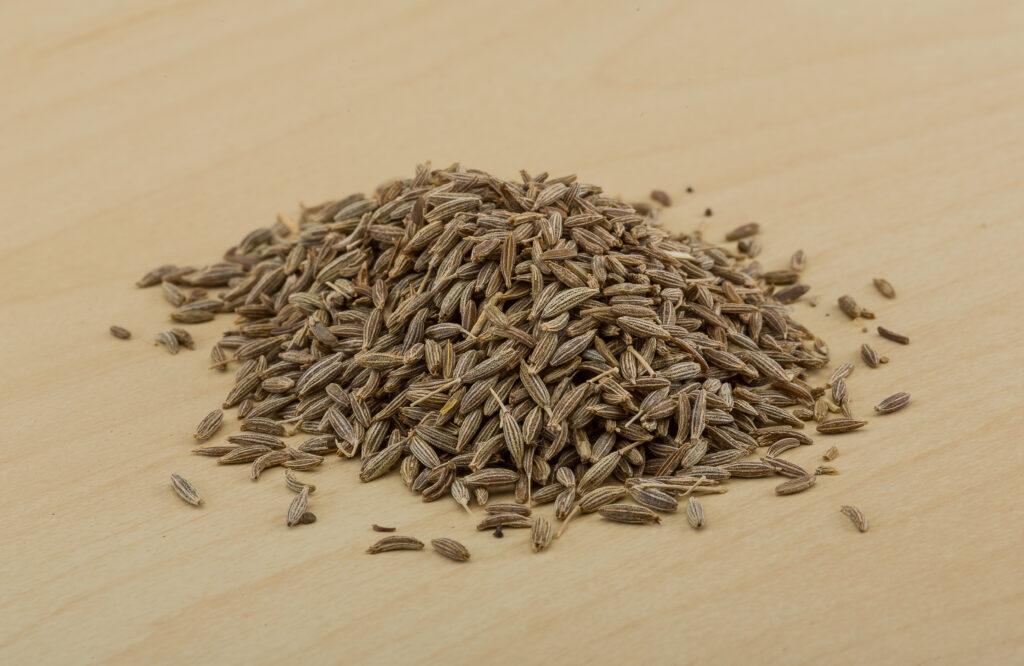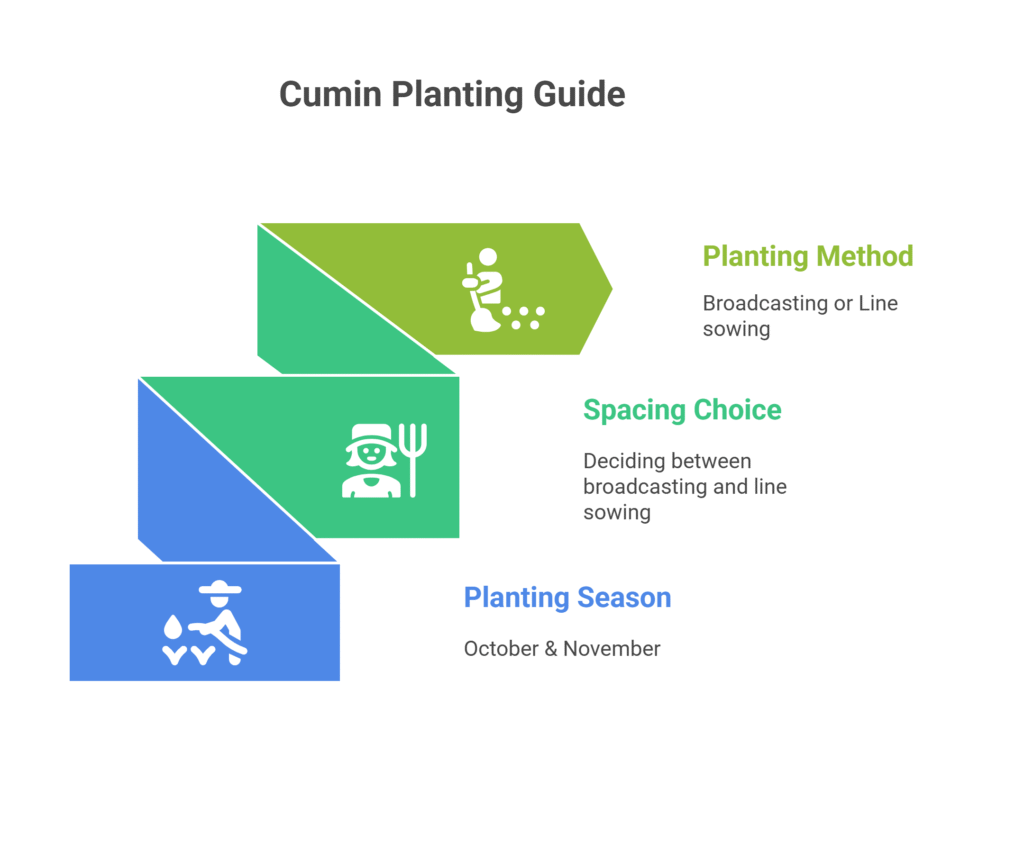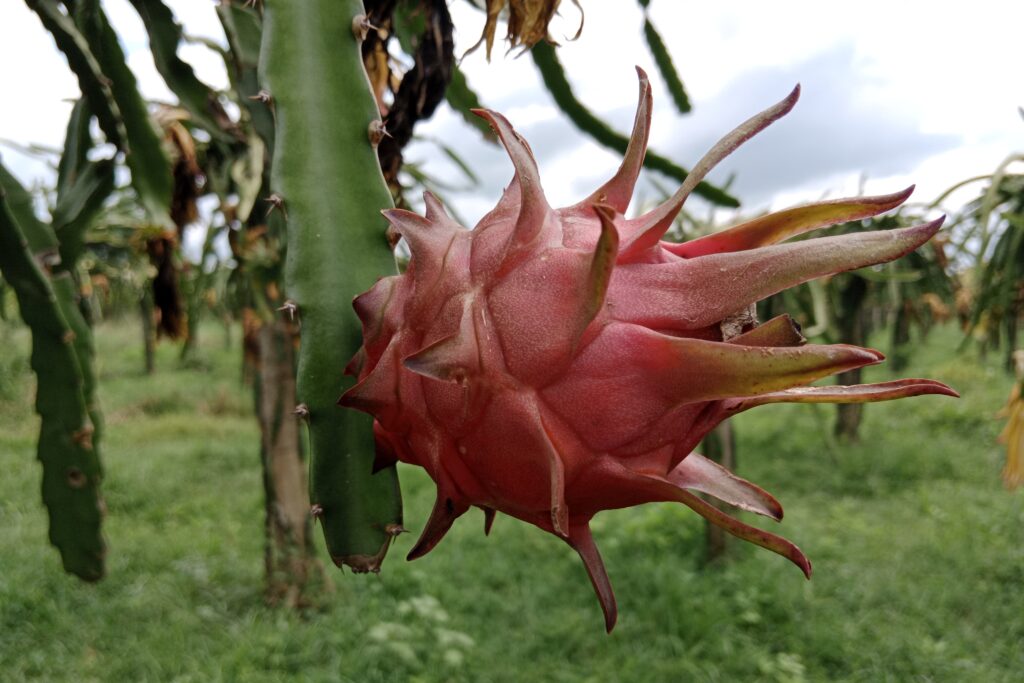Cumin Farming
Cumin (Cuminum cyminum) is a small, aromatic annual herb prized for its seeds, a vital spice globally. Thriving in warm, arid/semi-arid regions, successful cultivation requires attention to specific practices. Cumin farming on one acre of land yields a total income of NRs. 150,000 against the total cost of NRs. 45,000, resulting in a net profit of NRs. 105,000. The Cumin Farming Profit Per Acre showcases a strong Return on Investment (ROI) of approximately 233%, indicating that for every NRs. 1 invested, a return of NRs. 2.33 is earned.

Land Preparation
For successful cumin cultivation, land preparation plays a crucial role in ensuring proper seed germination and plant establishment. Begin with deep ploughing up to a depth of 20–25 cm using a soil-turning plough or disc harrow to break compacted layers and incorporate any remaining crop residues.
This should be followed by 2–3 cross harrowings or cultivations to further break down soil clods. Level the field meticulously with a plank or leveler to ensure uniform irrigation. It is essential that the soil has adequate residual moisture at the time of sowing; if the soil is too dry, pre-sowing irrigation should be applied. The final seedbed should be smooth and clod-free, providing ideal conditions for broadcasting the tiny cumin seeds.
Soil Type
Cumin grows best in well-drained sandy loam to loamy soils, which offer ideal conditions for root development and moisture management. While medium black soils with good drainage can also be used, heavy clay soils are unsuitable due to poor drainage and waterlogging risks. Additionally, highly saline or alkaline soils and those prone to surface crusting should be avoided, as they can hinder seedling emergence and overall crop growth. The preferred soil pH for cumin cultivation ranges from slightly acidic to neutral, ideally between 6.8 and 7.5. Cumin seedlings are extremely sensitive to soil salinity.
Climatic Requirements
| Category | Requirement/Parameter | Details/Notes |
| Climate Type | Overall Preference | Cool and dry climate during the growing period is crucial. |
| Season | Primarily a rabi (winter) season crop. | |
| Temperature | Germination | |
| Optimal Range | 20-30°C (Optimal around 25°C) | |
| Critical Hazard | Frost is highly detrimental. | |
| Vegetative Growth | ||
| Daytime Range | 25-30°C | |
| Night Preference | Cooler nights | |
| Flowering & Seed Setting | ||
| Optimal Range | Cooler temperatures (20-25°C) | |
| Critical Conditions | Low humidity and clear skies are essential. | |
| Critical Hazard | High humidity or rain drastically increases disease risk and reduces yield/quality. | |
| Rainfall | Annual Preference | Low to moderate (around 300-500 mm annually) is suitable. |
| Critical Hazard Period | Excess rain during flowering and maturity is highly detrimental. | |
| Hazard Effects | Causes diseases and seed sprouting. | |
| Water Source | Reliance on irrigation is common. |
Major Cultivars
Cultivar selection depends on factors like region, disease resistance, maturity period, and seed yield/quality. As new varieties are continuously developed, consulting local agricultural universities or stations is recommended for the best options. Common cultivars include:
| Cultivar Names | Series/Type | Key Characteristics | Region/Adaptation |
| GC-1, GC-2, GC-3, GC-4 | Gujarat Cumin series | High yielding; wilt resistant (especially GC-4) | Popular in Gujarat |
| RZ-19, RZ-209, RZ-223 | Rajasthan varieties | Adapted to local conditions | Adapted to Rajasthan |
| UC-198, UC-199 | Developed varieties | Developed for specific regional conditions | Specific regions |
| Local Landraces | Traditional varieties | Adapted to local environments; often lower yielding and more susceptible to diseases | Various regions (some areas) |
Seed Rate per Acre
The typical seed rate for cumin cultivation ranges from 4 to 6 kg per acre, depending on seed quality, sowing method, and soil conditions.

Planting
a). Planting Season
Cumin is typically sown from October to November, once the monsoon rain has subsided, and is harvested between February and March.

b). Spacing
Cumin can be sown either by broadcasting or line sowing. Broadcasting involves scattering seeds uniformly over the prepared field, which is common but less efficient. Line sowing is the preferred method, where seeds are placed in shallow furrows with a recommended row spacing of 20 cm for better crop management and yield.
c). Planting Method
| Planting Method | Description | ||
| Broadcasting | Seeds are mixed with fine sand, soil, or compost for even distribution and then lightly covered with soil or raked in. | ||
| Line Sowing (Drilling) | Seeds are sown in shallow furrows (1.5–2.5 cm deep) using a drill or hoe and covered lightly with soil. This method ensures better spacing, weed control, and efficient irrigation, and is highly recommended. | ||
Intercropping
Intercropping is a common practice in cumin cultivation, especially during the initial growth phase, to maximize land use and income. Cumin is often intercropped with compatible rabi crops such as coriander, mustard, chickpea (gram), and fenugreek (methi), typically arranged in paired rows or alternating strips. It is important to select companion crops that mature earlier or compete less for light, water, and nutrients to avoid negatively affecting cumin yield.
Irrigation
Cumin cultivation requires careful water management, as over-irrigation is a major cause of diseases. Typically, 4 to 6 irrigations are needed depending on soil type, climate, and rainfall, with the soil allowed to dry moderately between each irrigation.
A critical rule is to avoid watering during the peak flowering period to prevent flower drop and reduce the risk of diseases such as powdery mildew and wilt. Irrigation should be stopped completely 1 to 2 weeks before the expected harvest to ensure proper seed maturity and reduce post-harvest complications.
| Irrigation Stage | Timing (Days After Sowing – DAS) | Remarks |
| First Irrigation | Immediately after sowing | Apply only if soil moisture is insufficient. |
| Seedling Establishment | 15–20 DAS | Supports early root development and uniform crop stand. |
| Vegetative Growth Stage | 30–35 DAS | Promotes healthy plant growth and canopy development. |
| Flowering Initiation | 50–60 DAS | Crucial stage: adequate moisture is vital but avoid excess to prevent disease and flower drop. |
| Seed Development Stage | 70–80 DAS | Supports proper seed filling; maintain moderate moisture levels. |
Fertilizer and Manure
Fertilizer and manure application in cumin cultivation should be adjusted based on soil test results to ensure balanced nutrient supply and avoid over- or under-application. A general recommendation is given below on the table
| Application | Type | Rate per Acre | Specifications/Notes |
| Basal Dose (at last ploughing) | Farmyard Manure (FYM) | 8–10 tons | Must be well-decomposed |
| Biofertilizer | Azospirillum: 1 kg PSB: 1 kg | Phosphorus Solubilizing Bacteria (PSB) | |
| Nitrogen (N) | 20 kg (equivalent to 43 kg Urea) | Chemical fertilizer | |
| Phosphorus (P₂O₅) | 25 kg (equivalent to 156 kg SSP) | SSP = Single Super Phosphate | |
| Potassium (K₂O) | 10 kg (equivalent to 17 kg MOP) | MOP = Muriate of Potash | |
| Top Dressing | Nitrogen (N) | ~10 kg (equivalent to 22 kg Urea) | Apply 30–35 days after sowing during active vegetative growth; preferably before flowering; avoid late application |
Weed Control
Weed control is critical in cumin cultivation because the seedlings are small, slow-growing, and highly vulnerable to competition from weeds. Effective methods include applying a pre-emergence herbicide like Pendimethalin (1.0–1.25 kg a.i./ha) immediately after sowing but before both cumin and weed emergence, which controls many grasses and broadleaf weeds.
Early post-emergence options include Fluchloralin (used as a pre-plant incorporation) or careful application of Quizalofop-ethyl (targeting grasses only) after cumin emergence when weeds are still very small. Manual weeding through hand hoeing is essential, typically performed 2 to 3 times: first at 20–25 days after sowing (DAS), second at 40–45 DAS, and a third if necessary.
This also helps break soil crust and aerate the roots, making it especially important for organic production. Thinning is usually done during the first weeding to ensure proper plant spacing.
Flowering and Fruit Management
Flowering in cumin begins around 50–60 days after sowing and lasts for several weeks, characterized by small white to pinkish flowers arranged in compound umbels. The key management focus during this critical phase is protecting the crop from disease and stress.
Irrigation and rainfall should be avoided as they greatly increase the risk of powdery mildew and wilt, leading to flower and young fruit drop. Additionally, pests such as aphids may attack the flower heads and should be monitored closely.
Following pollination, fruits—called schizocarps or commonly seeds—develop, and the seed filling and maturation stage is crucial; any stress from drought, disease, or nutrient deficiency during this period can significantly reduce seed size, weight, and oil content.
Pest and Disease Management
Common Pests
a). Aphids
Aphids are sap-sucking pests that can also transmit harmful viruses to cumin plants. To control aphid infestations, insecticides such as Imidacloprid or Acetamiprid can be applied at a rate of 1 ml per liter of water, or Dimethoate can be used as an alternative. Additionally, encouraging natural predators like ladybugs helps manage aphid populations in an eco-friendly way.
b). Thrips
Thrips damage flowers and young seeds, causing reduced yield and quality. To control them, applying Spinosad or Fipronil at 4 kg per acre is effective in protecting the crop and minimizing damage.
c). Cutworms
Cutworms are harmful larvae that attack young seedlings by severing them at the base, often causing significant stand loss and poor crop establishment. These pests remain hidden in the soil during the day and emerge at night to feed on the tender stems near the soil surface, making early detection difficult.
Effective control of cutworms involves using chemical treatments such as a drench of profenofos combined with cypermethrin at a concentration of 3 ml per liter of water, which targets the larvae in the soil. Additionally, applying poison bait can help reduce cutworm populations by attracting and killing the pests before they can damage more seedlings, thereby protecting the crop during its vulnerable early growth stages.
Common Diseases
a). Wilt
One of the most destructive crop diseases, wilt causes signs like leaf yellowing, wilting, and ultimately plant death. Usually brought on by soil-borne fungi, it can significantly lower production if left unchecked. Growing resistant cultivars like GC-4, making sure the soil drains properly, and avoiding waterlogging—which encourages the disease’s spread—are all examples of effective management techniques.
The disease cycle can be broken by rotating crops with non-host crops for three to four years. Furthermore, the occurrence and severity of wilt can be considerably decreased by treating seeds with fungicides like Carbendazim or Thiram at a rate of 2 g/kg of seed and soaking the soil with Carbendazim.
b). Powdery Mildew
On leaves and stems, powdery mildew manifests as a white, powdery growth, particularly in humid environments. To prevent humidity and disease spread, management measures include using sulfur dust (25 kg/ha) or fungicides such as Tebuconazole, Hexaconazole, or Dinocap (0.1%), as well as avoiding dense canopies and irrigation during flowering.
c). Alternaria Blight
Alternaria blight causes brown spots on leaves, stems, and umbels, leading to reduced plant vigor and yield. Effective management includes field sanitation to remove infected debris and spraying fungicides such as Mancozeb (0.25%), Chlorothalonil (0.2%), or Azoxystrobin at 0.5 ml per liter of water to control the spread of the disease.
Harvesting
Harvesting is a critical stage that directly affects the quality and yield of the crop. It should be done when the plants turn yellowish-brown and the seeds in the primary umbels at the top are fully mature, hard, and brown splitting a few umbels can help confirm maturity. Secondary umbels should also have mature seeds. It is generally better to harvest slightly earlier rather than late to minimize the risk of seed shattering and loss.

The harvesting method involves several key steps to ensure minimal seed loss and high-quality yield. First, plants are cut at ground level using a sickle early in the morning to reduce seed shattering. The cut plants are then bundled and stacked upright in the field for 4–7 days to allow sun-drying and uniform ripening of seeds in the later-developing umbels.
Once fully dry, the bundles are threshed either manually by beating with sticks or mechanically using a thresher to separate the seeds. The harvested seeds are then cleaned and winnowed using natural wind or a fan, followed by sieving to remove chaff, plant debris, and immature seeds. Finally, the cleaned seeds are sun-dried for an additional 4–5 days to bring moisture content below 10% for safe and long-term storage.
Yield
Under good management conditions, the typical yield ranges from 400 to 600 kg of clean, dried seeds per acre.
Cost of Investment Per Acre for Cumin Farming
| S.N. | Categories | Cost (NRs.) |
| 1 | Land Preparation (Plowing) | 15,000 |
| 2 | Seed | 5,000 |
| 3 | Sowing | 3,000 |
| 4 | Fertilizers and Manure | 5,000 |
| 5 | Irrigation | 3,000 |
| 6 | Weed Control (Pre & Post-emergence) | 2,000 |
| 7 | Pest & Disease Control | 3,000 |
| 8 | Harvesting | 5,000 |
| 9 | Miscellaneous Costs | 4,000 |
| Total Cost | 45,000 |
Income from per Acre Cumin Farming
| Particulars | Quantity/Rate | Amount (NRs.) | ||
| Estimated Yield | 500 kg/acre | |||
| Market Price | NRs. 300 per kg | |||
| Total Income | 500 kg × NRs. 300/kg | 150,000 | ||
Analysis of Cumin Farming Profit Per Acre
| Particulars | Amount (NRs.) |
| Total Income | 150,000 |
| Total Cost | 45,000 |
| Net Profit | 105,000 |
Cumin farming on 1 acre of land results in an estimated profit of NRs. 105,000, assuming a yield of 500 kg and a market price of NRs. 300 per kg under good management practices.
Crop Calendar for Cumin Farming
| Stage | Activities | Timeframe |
| Pre-Sowing (Land Prep) | Deep ploughing, harrowing, leveling, application of FYM and biofertilizers. | September – October |
| Sowing | Line sowing or broadcasting of 4–6 kg seed/acre; pre-emergence herbicide (Pendimethalin). | Mid-October – Mid-November |
| Germination & Establishment | First irrigation (if no residual moisture); aphid & cutworm monitoring. | Late October – Early December |
| Vegetative Growth | Top dressing with urea (30–35 DAS); first and second manual weeding; thinning. | December |
| Flowering Phase | Begins at 50–60 DAS; disease & pest control (powdery mildew, aphids, thrips). | January – Early February |
| Seed Development | Maintain light irrigation if needed; avoid excess water; stop irrigation 10–14 days before harvest. | February |
| Harvesting | Harvest when umbels turn brown; sun-dry bundles; thresh and clean seeds. | Late February – March |
| Post-Harvest | Final sun drying (4–5 days), proper packaging, and storage (<10% moisture). | March |
Sources
Food and Agriculture Organization (FAO)
Indian Council of Agricultural Research (ICAR)
National Horticulture Board (NHB)
Nepal Agricultural Research Coucil (NARC)
Punjab Agriculture University (PAU)
Tamil Nadu Agriculture University (TNAU) – Agritech portal


